International Finance Report: Financial Analysis and Risk Assessment
VerifiedAdded on 2021/04/21
|11
|1218
|120
Report
AI Summary
This report analyzes international finance, focusing on the financial strategies of companies operating internationally. Part A addresses questions related to investment returns in different countries (Thailand and Australia), currency depreciation, and the optimal allocation of funds to maximize returns while mitigating risks. Part B examines the foreign exchange risks faced by two Australian companies, Brambles Limited and Woodside Petroleum, detailing their revenue sources, risk management strategies (including forward contracts and cross-currency swaps), and the correlation between exchange rates and share prices. The report recommends secondary listings on international stock exchanges for increased flexibility in raising funds. It uses financial data, including interest rates, currency depreciation scenarios, and company performance metrics to support its analysis and recommendations. The report also includes a reference list of relevant academic sources.
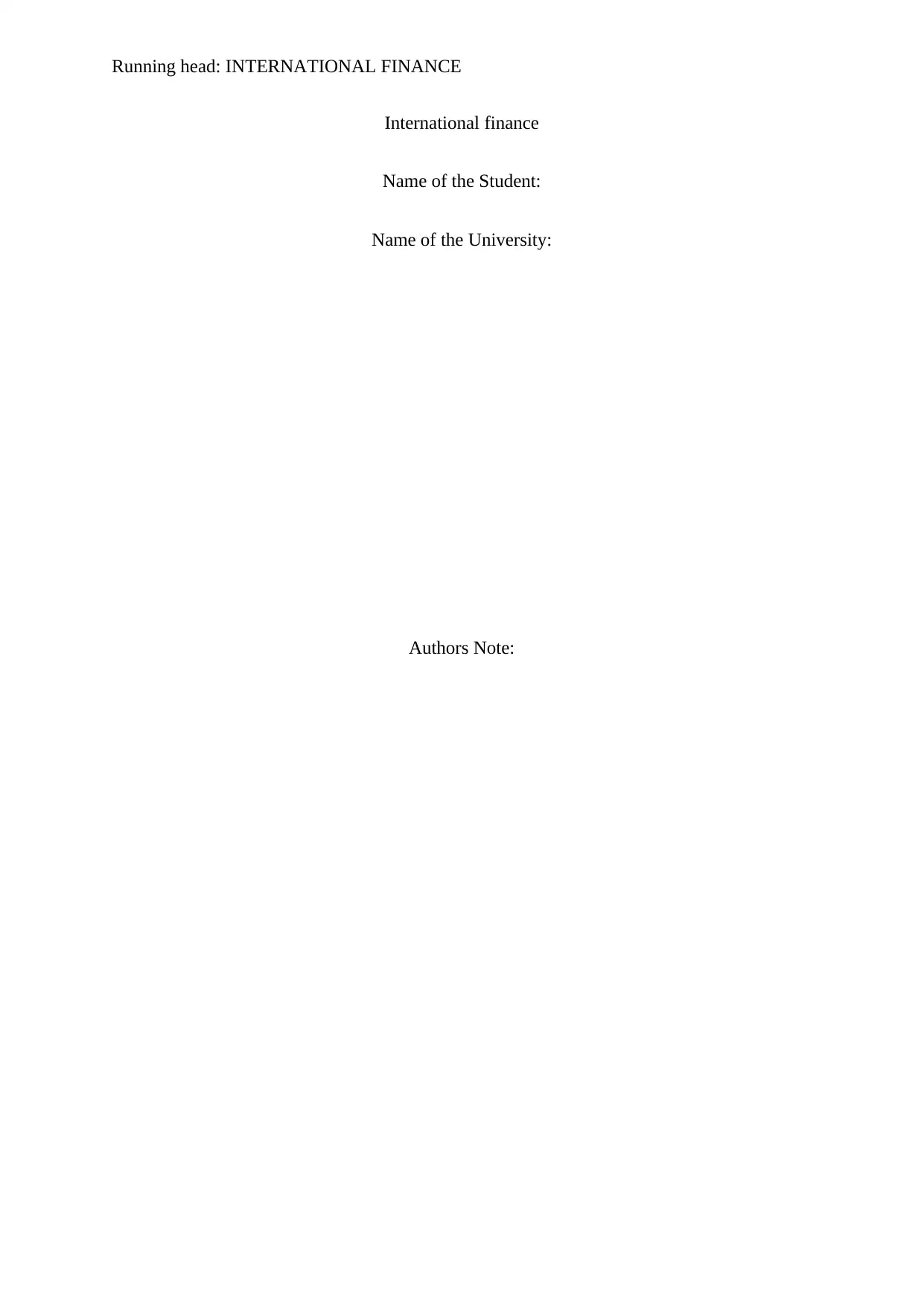
Running head: INTERNATIONAL FINANCE
International finance
Name of the Student:
Name of the University:
Authors Note:
International finance
Name of the Student:
Name of the University:
Authors Note:
Paraphrase This Document
Need a fresh take? Get an instant paraphrase of this document with our AI Paraphraser
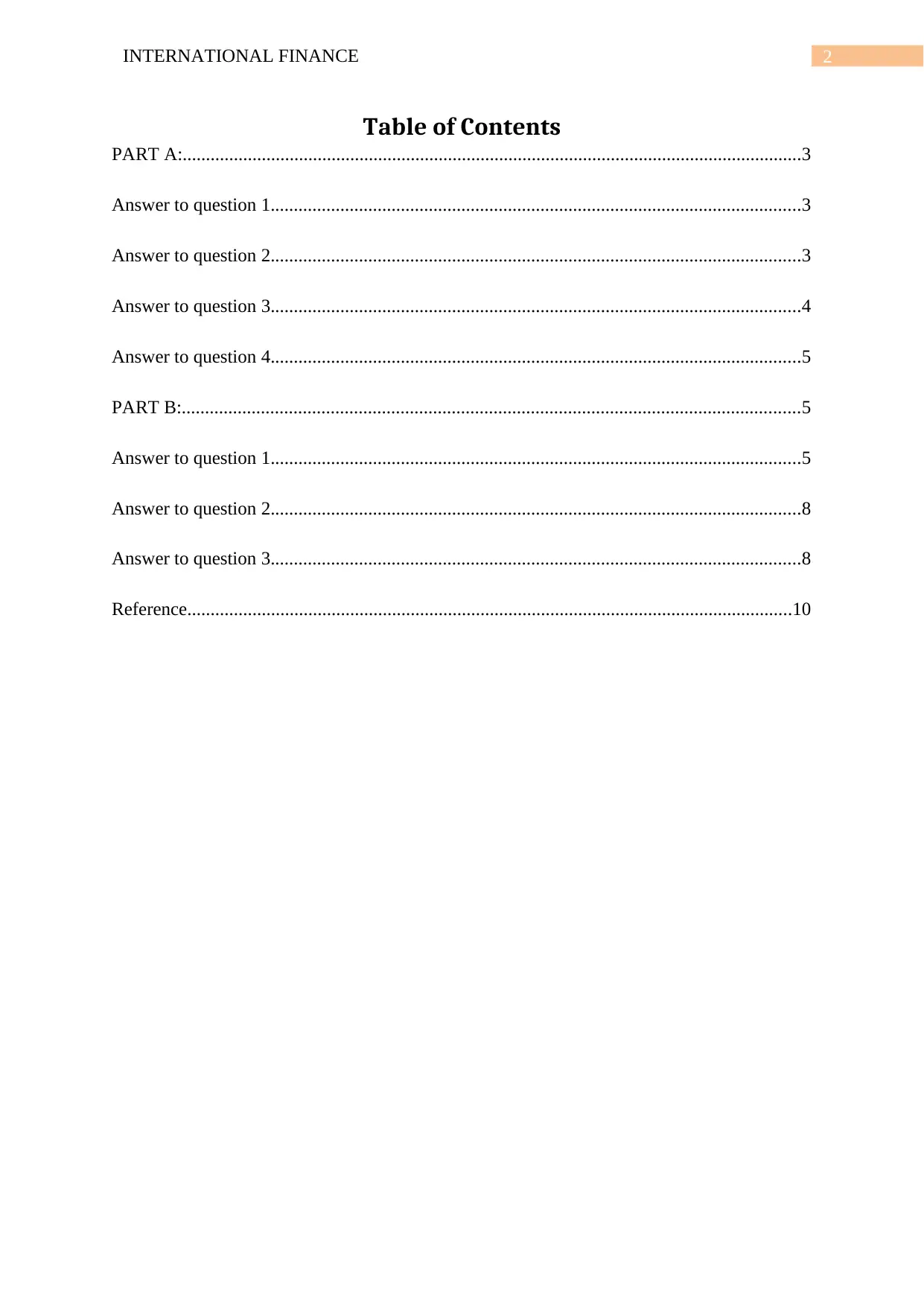
2INTERNATIONAL FINANCE
Table of Contents
PART A:.....................................................................................................................................3
Answer to question 1..................................................................................................................3
Answer to question 2..................................................................................................................3
Answer to question 3..................................................................................................................4
Answer to question 4..................................................................................................................5
PART B:.....................................................................................................................................5
Answer to question 1..................................................................................................................5
Answer to question 2..................................................................................................................8
Answer to question 3..................................................................................................................8
Reference..................................................................................................................................10
Table of Contents
PART A:.....................................................................................................................................3
Answer to question 1..................................................................................................................3
Answer to question 2..................................................................................................................3
Answer to question 3..................................................................................................................4
Answer to question 4..................................................................................................................5
PART B:.....................................................................................................................................5
Answer to question 1..................................................................................................................5
Answer to question 2..................................................................................................................8
Answer to question 3..................................................................................................................8
Reference..................................................................................................................................10
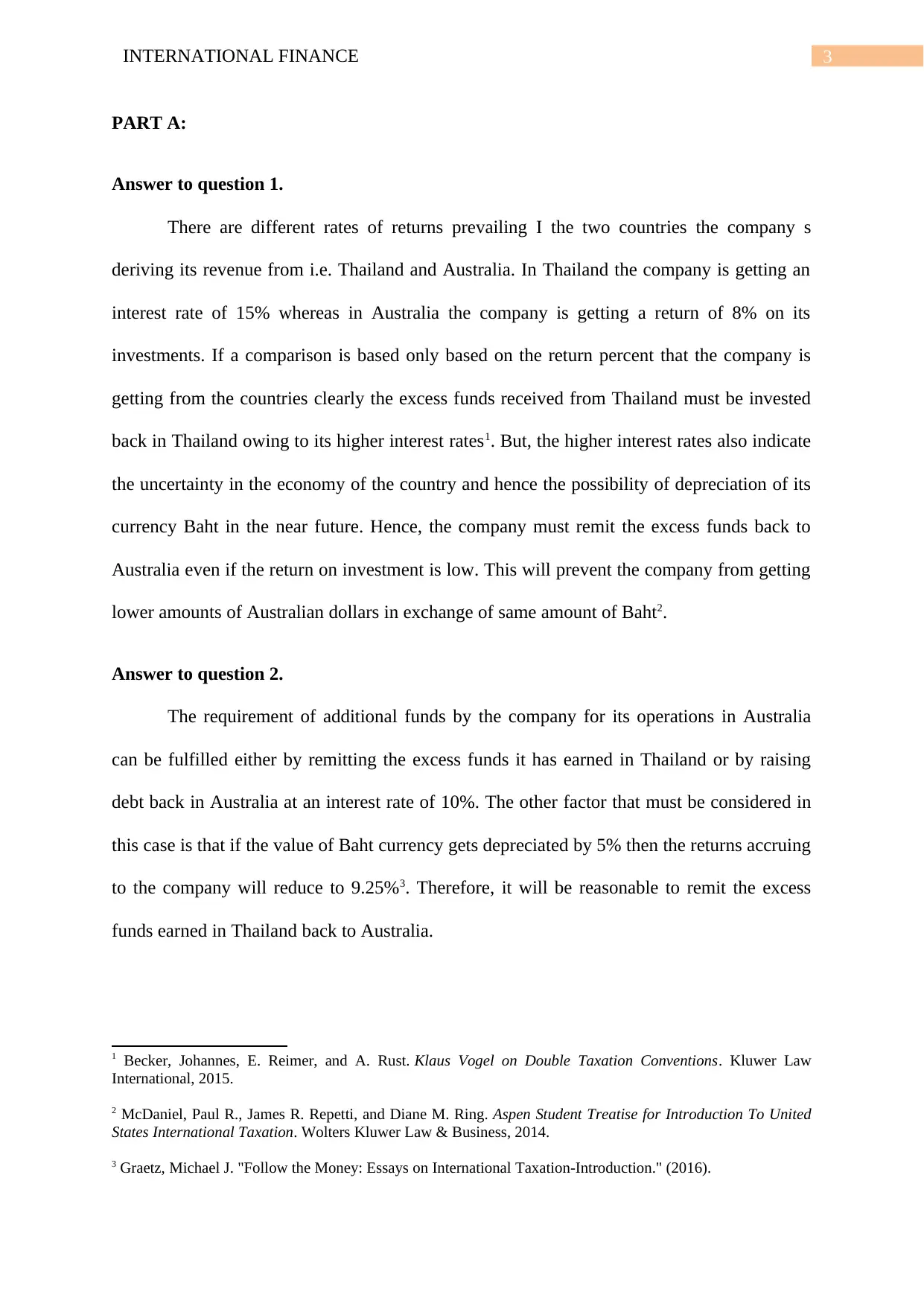
3INTERNATIONAL FINANCE
PART A:
Answer to question 1.
There are different rates of returns prevailing I the two countries the company s
deriving its revenue from i.e. Thailand and Australia. In Thailand the company is getting an
interest rate of 15% whereas in Australia the company is getting a return of 8% on its
investments. If a comparison is based only based on the return percent that the company is
getting from the countries clearly the excess funds received from Thailand must be invested
back in Thailand owing to its higher interest rates1. But, the higher interest rates also indicate
the uncertainty in the economy of the country and hence the possibility of depreciation of its
currency Baht in the near future. Hence, the company must remit the excess funds back to
Australia even if the return on investment is low. This will prevent the company from getting
lower amounts of Australian dollars in exchange of same amount of Baht2.
Answer to question 2.
The requirement of additional funds by the company for its operations in Australia
can be fulfilled either by remitting the excess funds it has earned in Thailand or by raising
debt back in Australia at an interest rate of 10%. The other factor that must be considered in
this case is that if the value of Baht currency gets depreciated by 5% then the returns accruing
to the company will reduce to 9.25%3. Therefore, it will be reasonable to remit the excess
funds earned in Thailand back to Australia.
1 Becker, Johannes, E. Reimer, and A. Rust. Klaus Vogel on Double Taxation Conventions. Kluwer Law
International, 2015.
2 McDaniel, Paul R., James R. Repetti, and Diane M. Ring. Aspen Student Treatise for Introduction To United
States International Taxation. Wolters Kluwer Law & Business, 2014.
3 Graetz, Michael J. "Follow the Money: Essays on International Taxation-Introduction." (2016).
PART A:
Answer to question 1.
There are different rates of returns prevailing I the two countries the company s
deriving its revenue from i.e. Thailand and Australia. In Thailand the company is getting an
interest rate of 15% whereas in Australia the company is getting a return of 8% on its
investments. If a comparison is based only based on the return percent that the company is
getting from the countries clearly the excess funds received from Thailand must be invested
back in Thailand owing to its higher interest rates1. But, the higher interest rates also indicate
the uncertainty in the economy of the country and hence the possibility of depreciation of its
currency Baht in the near future. Hence, the company must remit the excess funds back to
Australia even if the return on investment is low. This will prevent the company from getting
lower amounts of Australian dollars in exchange of same amount of Baht2.
Answer to question 2.
The requirement of additional funds by the company for its operations in Australia
can be fulfilled either by remitting the excess funds it has earned in Thailand or by raising
debt back in Australia at an interest rate of 10%. The other factor that must be considered in
this case is that if the value of Baht currency gets depreciated by 5% then the returns accruing
to the company will reduce to 9.25%3. Therefore, it will be reasonable to remit the excess
funds earned in Thailand back to Australia.
1 Becker, Johannes, E. Reimer, and A. Rust. Klaus Vogel on Double Taxation Conventions. Kluwer Law
International, 2015.
2 McDaniel, Paul R., James R. Repetti, and Diane M. Ring. Aspen Student Treatise for Introduction To United
States International Taxation. Wolters Kluwer Law & Business, 2014.
3 Graetz, Michael J. "Follow the Money: Essays on International Taxation-Introduction." (2016).
⊘ This is a preview!⊘
Do you want full access?
Subscribe today to unlock all pages.

Trusted by 1+ million students worldwide
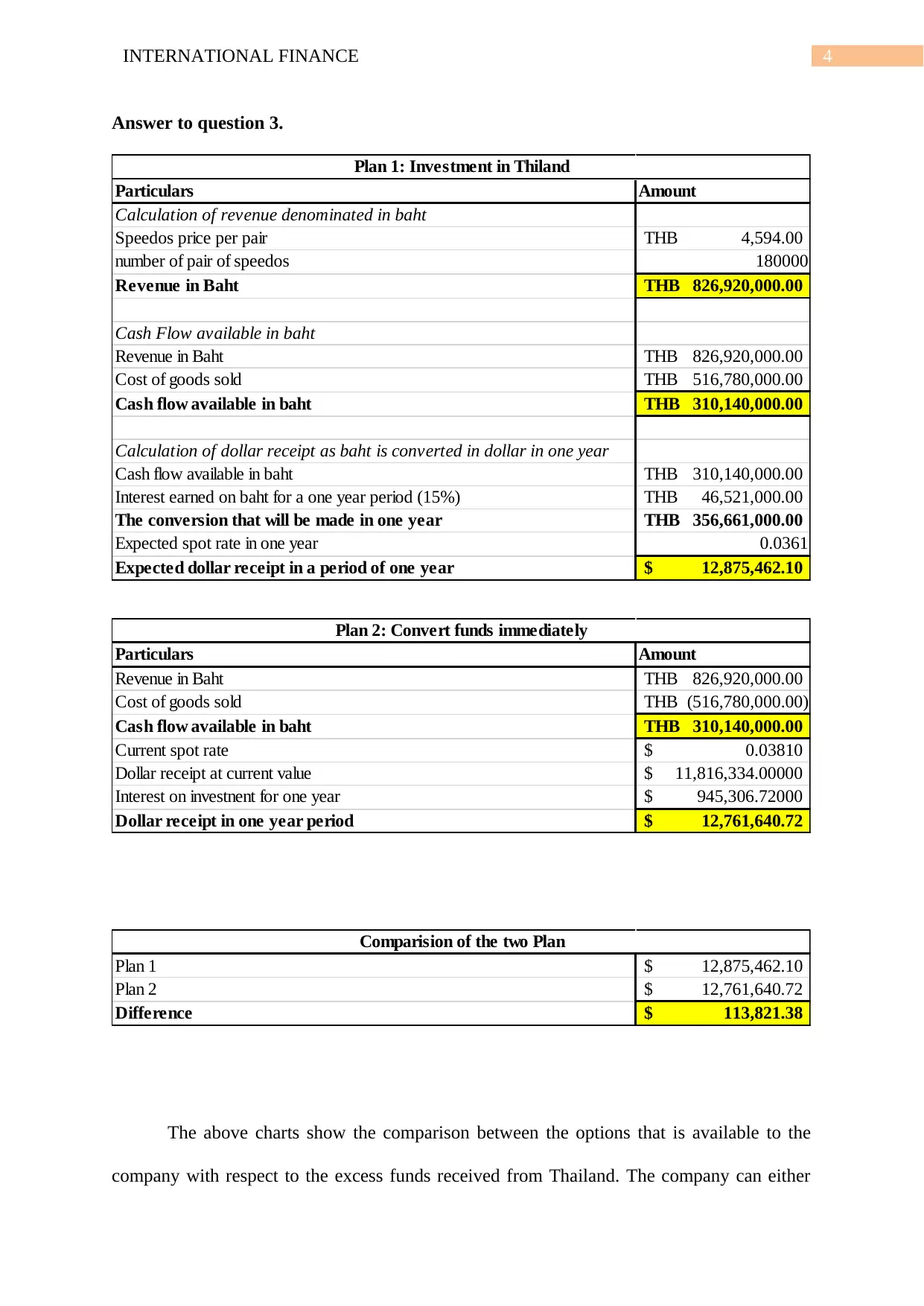
4INTERNATIONAL FINANCE
Answer to question 3.
Particulars Amount
Calculation of revenue denominated in baht
Speedos price per pair 4,594.00THB
number of pair of speedos 180000
Revenue in Baht 826,920,000.00THB
Cash Flow available in baht
Revenue in Baht 826,920,000.00THB
Cost of goods sold 516,780,000.00THB
Cash flow available in baht 310,140,000.00THB
Calculation of dollar receipt as baht is converted in dollar in one year
Cash flow available in baht 310,140,000.00THB
Interest earned on baht for a one year period (15%) 46,521,000.00THB
The conversion that will be made in one year 356,661,000.00THB
Expected spot rate in one year 0.0361
Expected dollar receipt in a period of one year 12,875,462.10$
Plan 1: Investment in Thiland
Particulars Amount
Revenue in Baht 826,920,000.00THB
Cost of goods sold (516,780,000.00)THB
Cash flow available in baht 310,140,000.00THB
Current spot rate 0.03810$
Dollar receipt at current value 11,816,334.00000$
Interest on investnent for one year 945,306.72000$
Dollar receipt in one year period 12,761,640.72$
Plan 2: Convert funds immediately
Plan 1 12,875,462.10$
Plan 2 12,761,640.72$
Difference 113,821.38$
Comparision of the two Plan
The above charts show the comparison between the options that is available to the
company with respect to the excess funds received from Thailand. The company can either
Answer to question 3.
Particulars Amount
Calculation of revenue denominated in baht
Speedos price per pair 4,594.00THB
number of pair of speedos 180000
Revenue in Baht 826,920,000.00THB
Cash Flow available in baht
Revenue in Baht 826,920,000.00THB
Cost of goods sold 516,780,000.00THB
Cash flow available in baht 310,140,000.00THB
Calculation of dollar receipt as baht is converted in dollar in one year
Cash flow available in baht 310,140,000.00THB
Interest earned on baht for a one year period (15%) 46,521,000.00THB
The conversion that will be made in one year 356,661,000.00THB
Expected spot rate in one year 0.0361
Expected dollar receipt in a period of one year 12,875,462.10$
Plan 1: Investment in Thiland
Particulars Amount
Revenue in Baht 826,920,000.00THB
Cost of goods sold (516,780,000.00)THB
Cash flow available in baht 310,140,000.00THB
Current spot rate 0.03810$
Dollar receipt at current value 11,816,334.00000$
Interest on investnent for one year 945,306.72000$
Dollar receipt in one year period 12,761,640.72$
Plan 2: Convert funds immediately
Plan 1 12,875,462.10$
Plan 2 12,761,640.72$
Difference 113,821.38$
Comparision of the two Plan
The above charts show the comparison between the options that is available to the
company with respect to the excess funds received from Thailand. The company can either
Paraphrase This Document
Need a fresh take? Get an instant paraphrase of this document with our AI Paraphraser
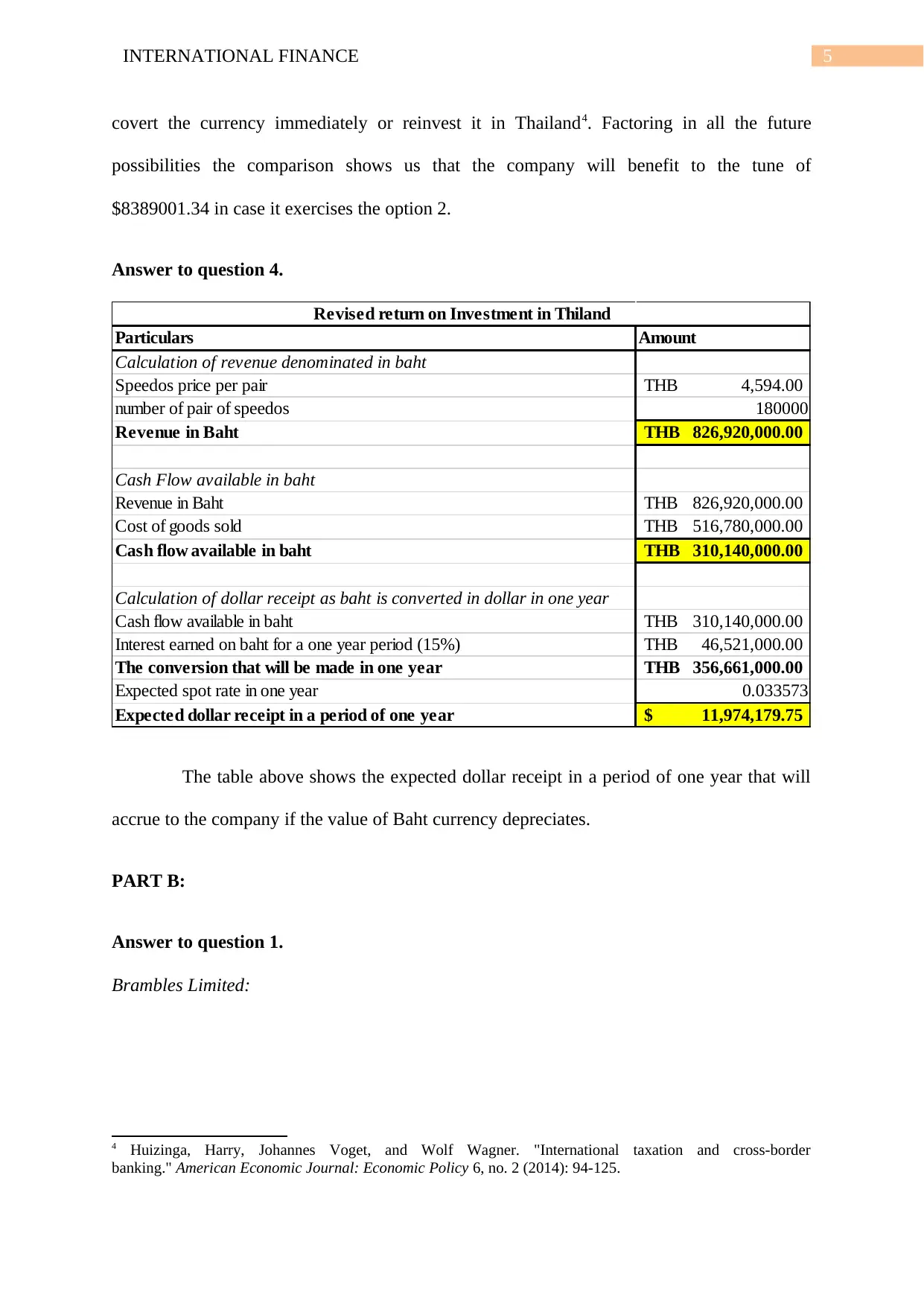
5INTERNATIONAL FINANCE
covert the currency immediately or reinvest it in Thailand4. Factoring in all the future
possibilities the comparison shows us that the company will benefit to the tune of
$8389001.34 in case it exercises the option 2.
Answer to question 4.
Particulars Amount
Calculation of revenue denominated in baht
Speedos price per pair 4,594.00THB
number of pair of speedos 180000
Revenue in Baht 826,920,000.00THB
Cash Flow available in baht
Revenue in Baht 826,920,000.00THB
Cost of goods sold 516,780,000.00THB
Cash flow available in baht 310,140,000.00THB
Calculation of dollar receipt as baht is converted in dollar in one year
Cash flow available in baht 310,140,000.00THB
Interest earned on baht for a one year period (15%) 46,521,000.00THB
The conversion that will be made in one year 356,661,000.00THB
Expected spot rate in one year 0.033573
Expected dollar receipt in a period of one year 11,974,179.75$
Revised return on Investment in Thiland
The table above shows the expected dollar receipt in a period of one year that will
accrue to the company if the value of Baht currency depreciates.
PART B:
Answer to question 1.
Brambles Limited:
4 Huizinga, Harry, Johannes Voget, and Wolf Wagner. "International taxation and cross-border
banking." American Economic Journal: Economic Policy 6, no. 2 (2014): 94-125.
covert the currency immediately or reinvest it in Thailand4. Factoring in all the future
possibilities the comparison shows us that the company will benefit to the tune of
$8389001.34 in case it exercises the option 2.
Answer to question 4.
Particulars Amount
Calculation of revenue denominated in baht
Speedos price per pair 4,594.00THB
number of pair of speedos 180000
Revenue in Baht 826,920,000.00THB
Cash Flow available in baht
Revenue in Baht 826,920,000.00THB
Cost of goods sold 516,780,000.00THB
Cash flow available in baht 310,140,000.00THB
Calculation of dollar receipt as baht is converted in dollar in one year
Cash flow available in baht 310,140,000.00THB
Interest earned on baht for a one year period (15%) 46,521,000.00THB
The conversion that will be made in one year 356,661,000.00THB
Expected spot rate in one year 0.033573
Expected dollar receipt in a period of one year 11,974,179.75$
Revised return on Investment in Thiland
The table above shows the expected dollar receipt in a period of one year that will
accrue to the company if the value of Baht currency depreciates.
PART B:
Answer to question 1.
Brambles Limited:
4 Huizinga, Harry, Johannes Voget, and Wolf Wagner. "International taxation and cross-border
banking." American Economic Journal: Economic Policy 6, no. 2 (2014): 94-125.
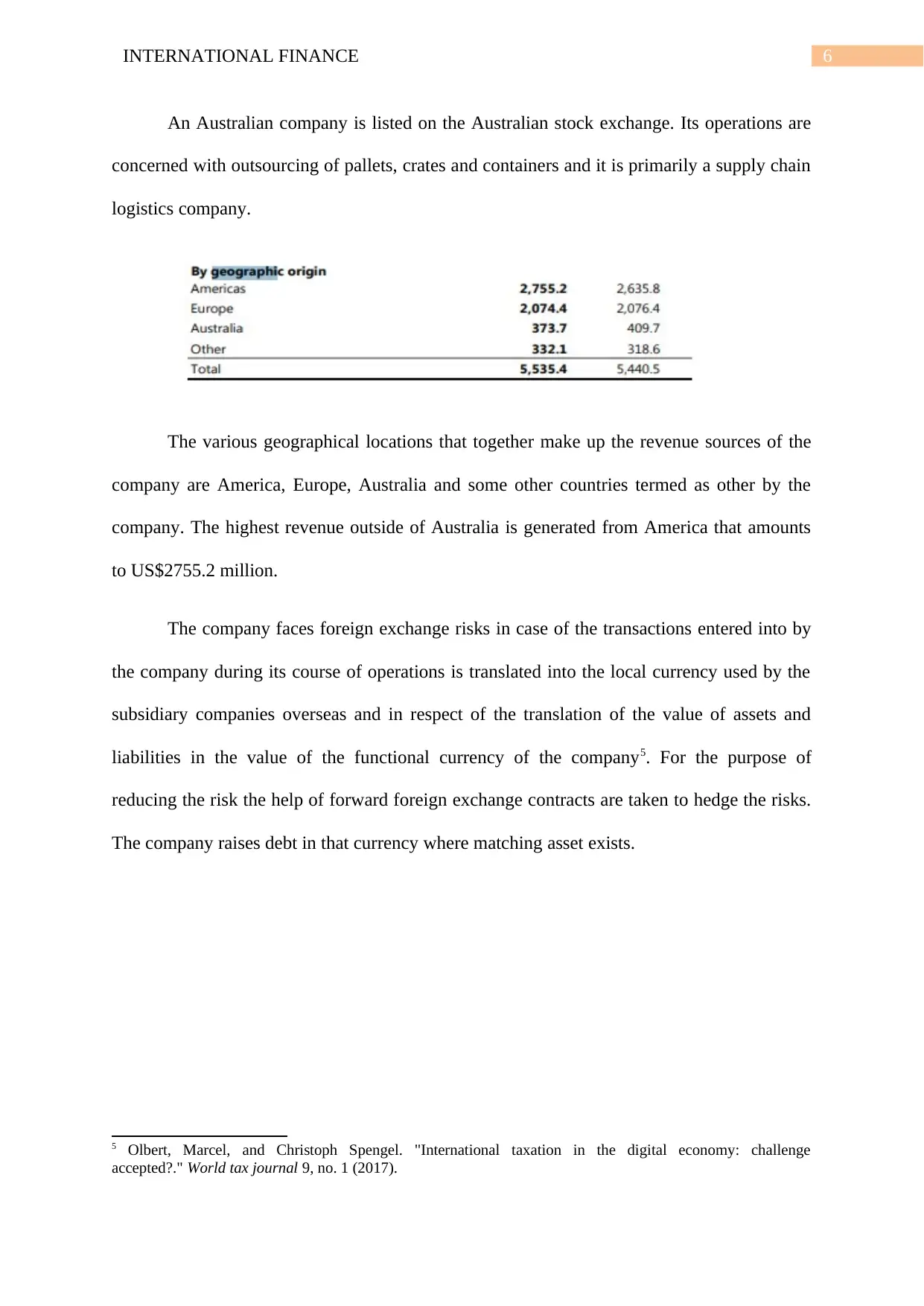
6INTERNATIONAL FINANCE
An Australian company is listed on the Australian stock exchange. Its operations are
concerned with outsourcing of pallets, crates and containers and it is primarily a supply chain
logistics company.
The various geographical locations that together make up the revenue sources of the
company are America, Europe, Australia and some other countries termed as other by the
company. The highest revenue outside of Australia is generated from America that amounts
to US$2755.2 million.
The company faces foreign exchange risks in case of the transactions entered into by
the company during its course of operations is translated into the local currency used by the
subsidiary companies overseas and in respect of the translation of the value of assets and
liabilities in the value of the functional currency of the company5. For the purpose of
reducing the risk the help of forward foreign exchange contracts are taken to hedge the risks.
The company raises debt in that currency where matching asset exists.
5 Olbert, Marcel, and Christoph Spengel. "International taxation in the digital economy: challenge
accepted?." World tax journal 9, no. 1 (2017).
An Australian company is listed on the Australian stock exchange. Its operations are
concerned with outsourcing of pallets, crates and containers and it is primarily a supply chain
logistics company.
The various geographical locations that together make up the revenue sources of the
company are America, Europe, Australia and some other countries termed as other by the
company. The highest revenue outside of Australia is generated from America that amounts
to US$2755.2 million.
The company faces foreign exchange risks in case of the transactions entered into by
the company during its course of operations is translated into the local currency used by the
subsidiary companies overseas and in respect of the translation of the value of assets and
liabilities in the value of the functional currency of the company5. For the purpose of
reducing the risk the help of forward foreign exchange contracts are taken to hedge the risks.
The company raises debt in that currency where matching asset exists.
5 Olbert, Marcel, and Christoph Spengel. "International taxation in the digital economy: challenge
accepted?." World tax journal 9, no. 1 (2017).
⊘ This is a preview!⊘
Do you want full access?
Subscribe today to unlock all pages.

Trusted by 1+ million students worldwide
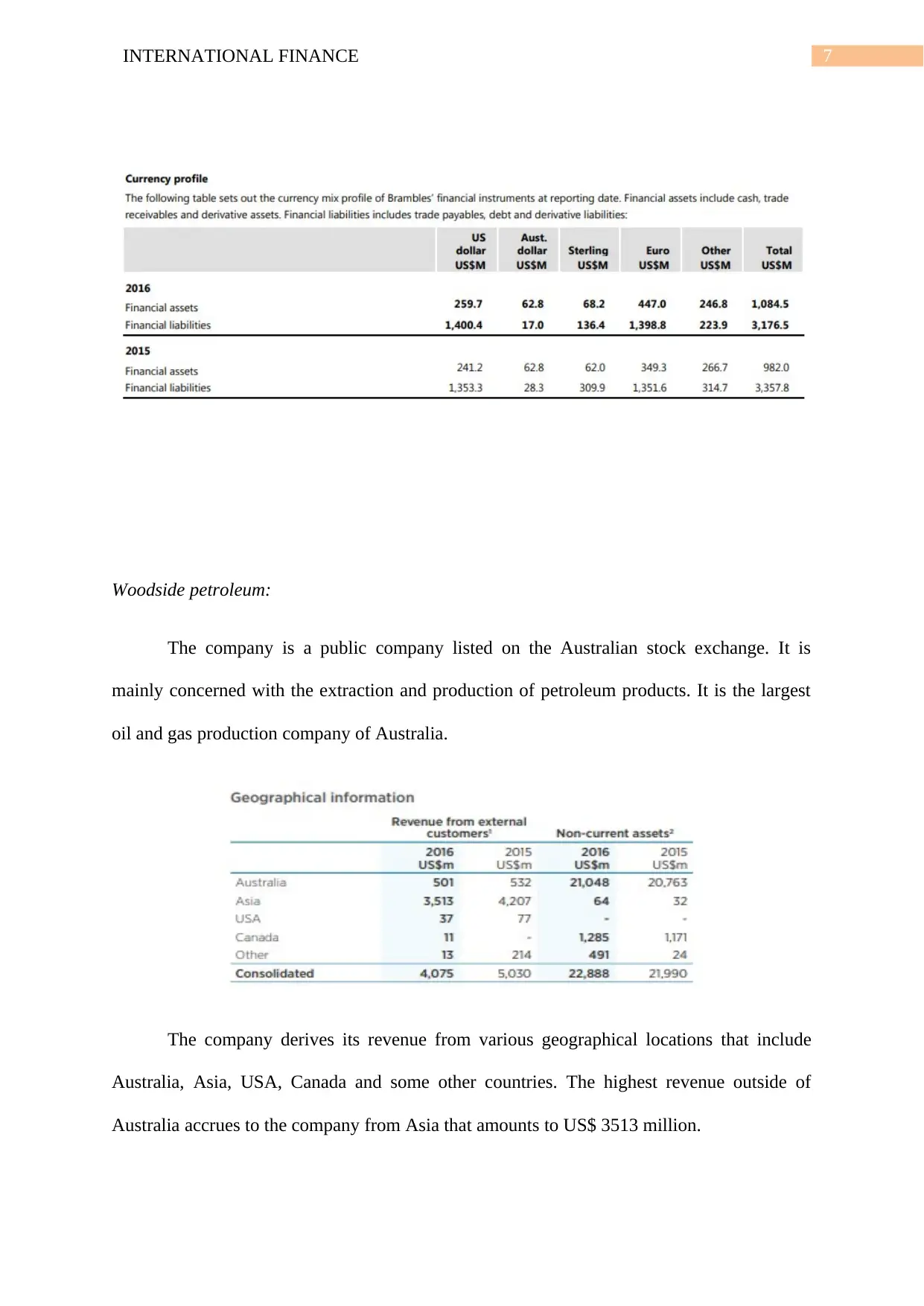
7INTERNATIONAL FINANCE
Woodside petroleum:
The company is a public company listed on the Australian stock exchange. It is
mainly concerned with the extraction and production of petroleum products. It is the largest
oil and gas production company of Australia.
The company derives its revenue from various geographical locations that include
Australia, Asia, USA, Canada and some other countries. The highest revenue outside of
Australia accrues to the company from Asia that amounts to US$ 3513 million.
Woodside petroleum:
The company is a public company listed on the Australian stock exchange. It is
mainly concerned with the extraction and production of petroleum products. It is the largest
oil and gas production company of Australia.
The company derives its revenue from various geographical locations that include
Australia, Asia, USA, Canada and some other countries. The highest revenue outside of
Australia accrues to the company from Asia that amounts to US$ 3513 million.
Paraphrase This Document
Need a fresh take? Get an instant paraphrase of this document with our AI Paraphraser
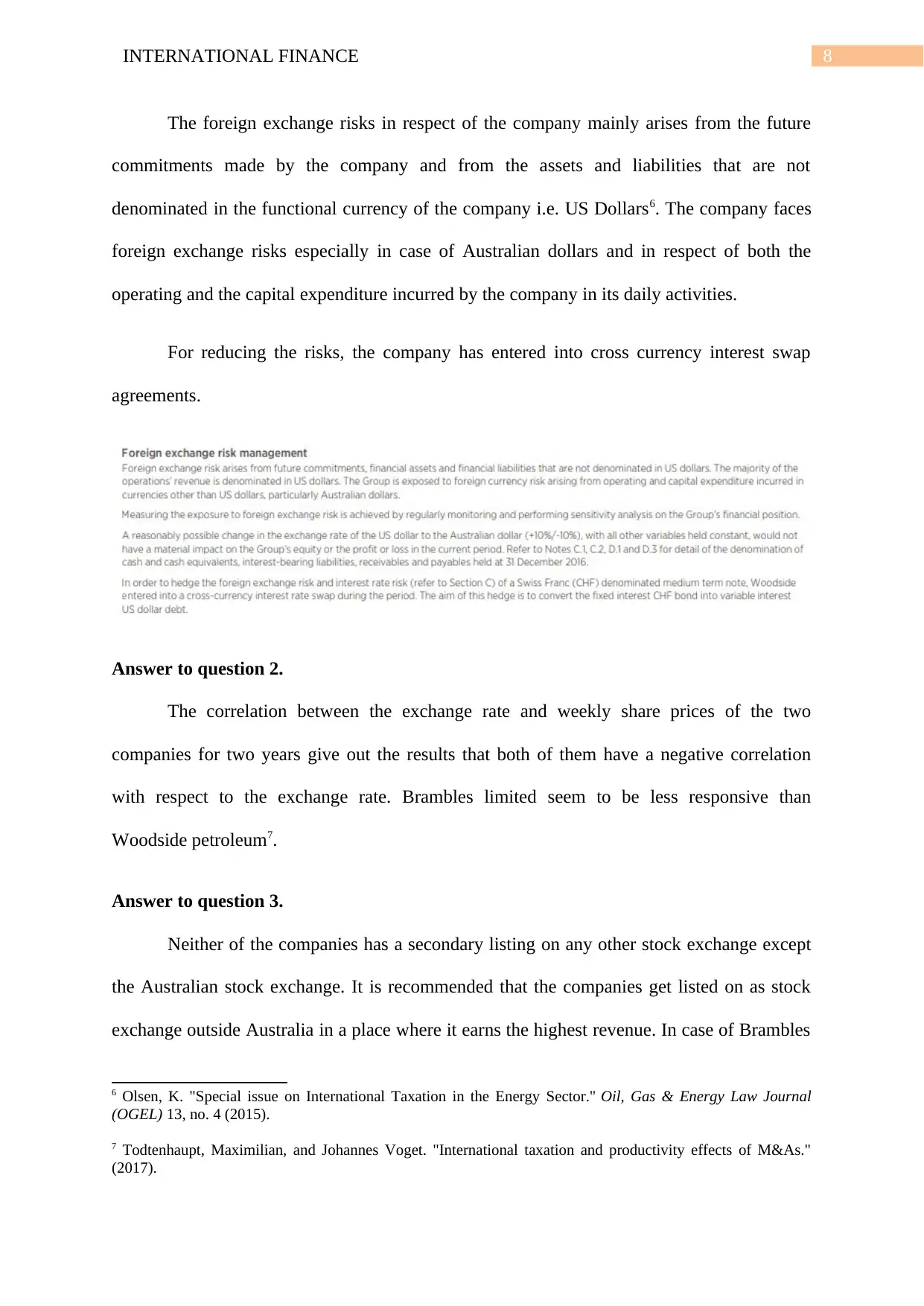
8INTERNATIONAL FINANCE
The foreign exchange risks in respect of the company mainly arises from the future
commitments made by the company and from the assets and liabilities that are not
denominated in the functional currency of the company i.e. US Dollars6. The company faces
foreign exchange risks especially in case of Australian dollars and in respect of both the
operating and the capital expenditure incurred by the company in its daily activities.
For reducing the risks, the company has entered into cross currency interest swap
agreements.
Answer to question 2.
The correlation between the exchange rate and weekly share prices of the two
companies for two years give out the results that both of them have a negative correlation
with respect to the exchange rate. Brambles limited seem to be less responsive than
Woodside petroleum7.
Answer to question 3.
Neither of the companies has a secondary listing on any other stock exchange except
the Australian stock exchange. It is recommended that the companies get listed on as stock
exchange outside Australia in a place where it earns the highest revenue. In case of Brambles
6 Olsen, K. "Special issue on International Taxation in the Energy Sector." Oil, Gas & Energy Law Journal
(OGEL) 13, no. 4 (2015).
7 Todtenhaupt, Maximilian, and Johannes Voget. "International taxation and productivity effects of M&As."
(2017).
The foreign exchange risks in respect of the company mainly arises from the future
commitments made by the company and from the assets and liabilities that are not
denominated in the functional currency of the company i.e. US Dollars6. The company faces
foreign exchange risks especially in case of Australian dollars and in respect of both the
operating and the capital expenditure incurred by the company in its daily activities.
For reducing the risks, the company has entered into cross currency interest swap
agreements.
Answer to question 2.
The correlation between the exchange rate and weekly share prices of the two
companies for two years give out the results that both of them have a negative correlation
with respect to the exchange rate. Brambles limited seem to be less responsive than
Woodside petroleum7.
Answer to question 3.
Neither of the companies has a secondary listing on any other stock exchange except
the Australian stock exchange. It is recommended that the companies get listed on as stock
exchange outside Australia in a place where it earns the highest revenue. In case of Brambles
6 Olsen, K. "Special issue on International Taxation in the Energy Sector." Oil, Gas & Energy Law Journal
(OGEL) 13, no. 4 (2015).
7 Todtenhaupt, Maximilian, and Johannes Voget. "International taxation and productivity effects of M&As."
(2017).
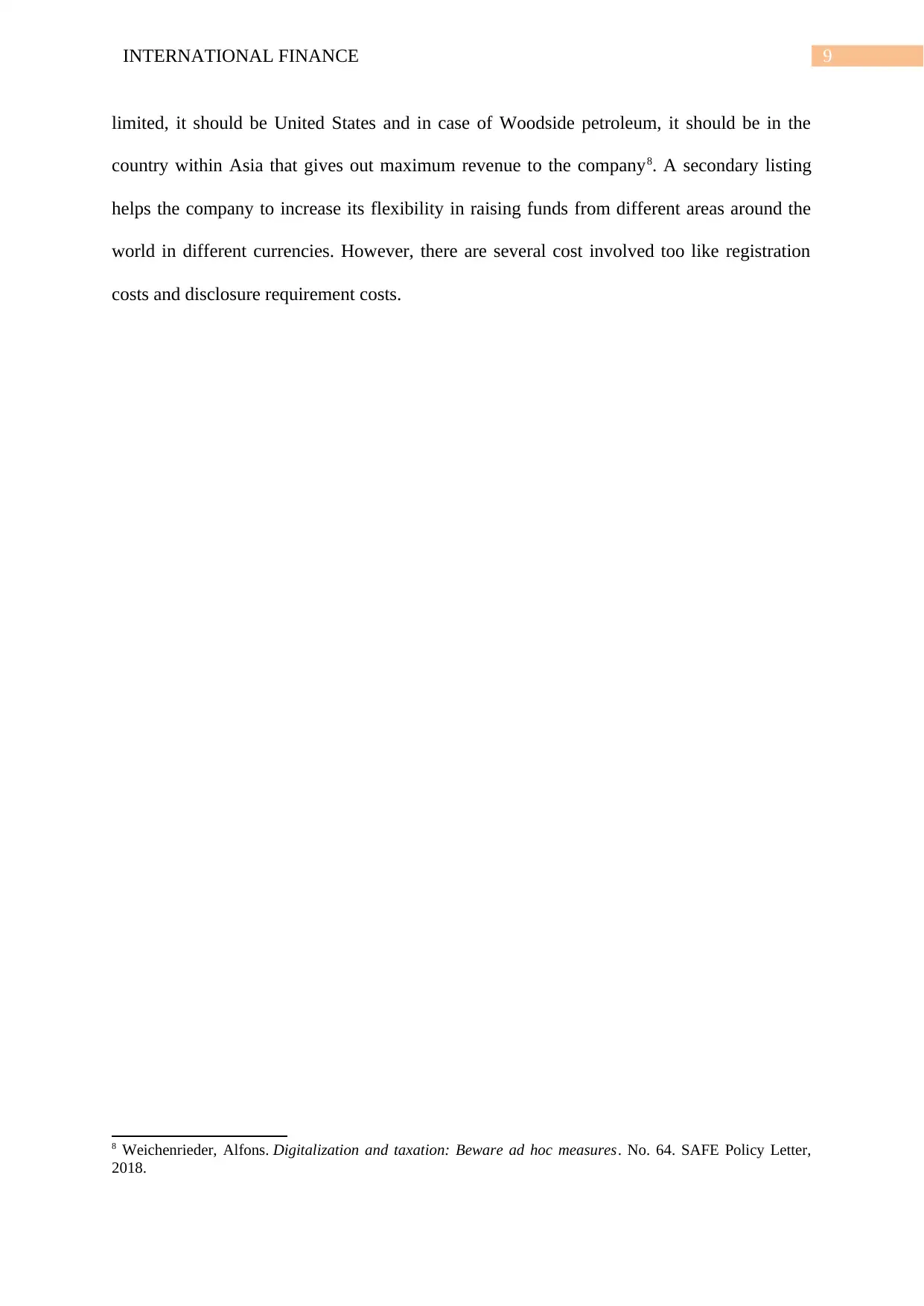
9INTERNATIONAL FINANCE
limited, it should be United States and in case of Woodside petroleum, it should be in the
country within Asia that gives out maximum revenue to the company8. A secondary listing
helps the company to increase its flexibility in raising funds from different areas around the
world in different currencies. However, there are several cost involved too like registration
costs and disclosure requirement costs.
8 Weichenrieder, Alfons. Digitalization and taxation: Beware ad hoc measures. No. 64. SAFE Policy Letter,
2018.
limited, it should be United States and in case of Woodside petroleum, it should be in the
country within Asia that gives out maximum revenue to the company8. A secondary listing
helps the company to increase its flexibility in raising funds from different areas around the
world in different currencies. However, there are several cost involved too like registration
costs and disclosure requirement costs.
8 Weichenrieder, Alfons. Digitalization and taxation: Beware ad hoc measures. No. 64. SAFE Policy Letter,
2018.
⊘ This is a preview!⊘
Do you want full access?
Subscribe today to unlock all pages.

Trusted by 1+ million students worldwide
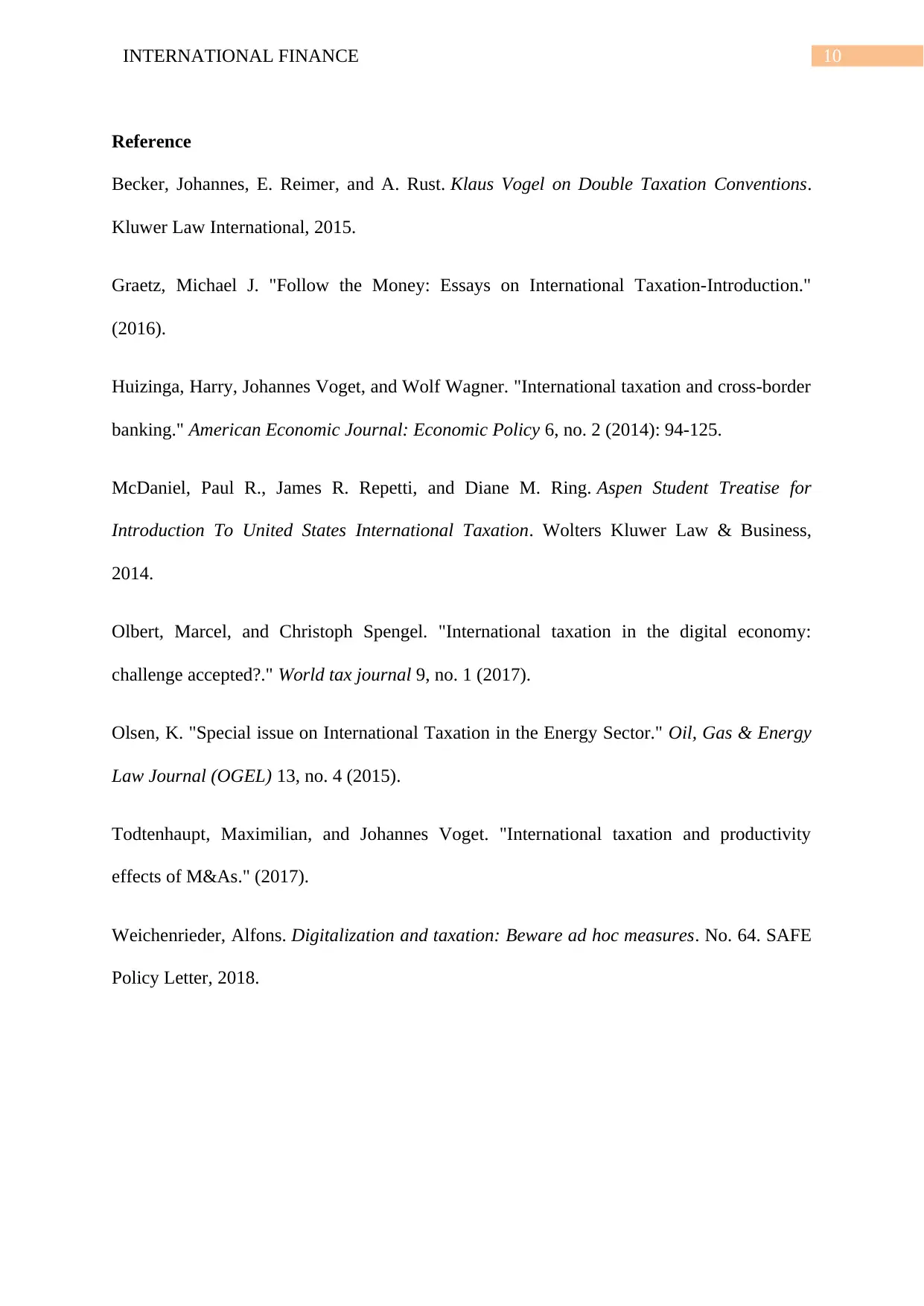
10INTERNATIONAL FINANCE
Reference
Becker, Johannes, E. Reimer, and A. Rust. Klaus Vogel on Double Taxation Conventions.
Kluwer Law International, 2015.
Graetz, Michael J. "Follow the Money: Essays on International Taxation-Introduction."
(2016).
Huizinga, Harry, Johannes Voget, and Wolf Wagner. "International taxation and cross-border
banking." American Economic Journal: Economic Policy 6, no. 2 (2014): 94-125.
McDaniel, Paul R., James R. Repetti, and Diane M. Ring. Aspen Student Treatise for
Introduction To United States International Taxation. Wolters Kluwer Law & Business,
2014.
Olbert, Marcel, and Christoph Spengel. "International taxation in the digital economy:
challenge accepted?." World tax journal 9, no. 1 (2017).
Olsen, K. "Special issue on International Taxation in the Energy Sector." Oil, Gas & Energy
Law Journal (OGEL) 13, no. 4 (2015).
Todtenhaupt, Maximilian, and Johannes Voget. "International taxation and productivity
effects of M&As." (2017).
Weichenrieder, Alfons. Digitalization and taxation: Beware ad hoc measures. No. 64. SAFE
Policy Letter, 2018.
Reference
Becker, Johannes, E. Reimer, and A. Rust. Klaus Vogel on Double Taxation Conventions.
Kluwer Law International, 2015.
Graetz, Michael J. "Follow the Money: Essays on International Taxation-Introduction."
(2016).
Huizinga, Harry, Johannes Voget, and Wolf Wagner. "International taxation and cross-border
banking." American Economic Journal: Economic Policy 6, no. 2 (2014): 94-125.
McDaniel, Paul R., James R. Repetti, and Diane M. Ring. Aspen Student Treatise for
Introduction To United States International Taxation. Wolters Kluwer Law & Business,
2014.
Olbert, Marcel, and Christoph Spengel. "International taxation in the digital economy:
challenge accepted?." World tax journal 9, no. 1 (2017).
Olsen, K. "Special issue on International Taxation in the Energy Sector." Oil, Gas & Energy
Law Journal (OGEL) 13, no. 4 (2015).
Todtenhaupt, Maximilian, and Johannes Voget. "International taxation and productivity
effects of M&As." (2017).
Weichenrieder, Alfons. Digitalization and taxation: Beware ad hoc measures. No. 64. SAFE
Policy Letter, 2018.
Paraphrase This Document
Need a fresh take? Get an instant paraphrase of this document with our AI Paraphraser

11INTERNATIONAL FINANCE
1 out of 11
Related Documents
Your All-in-One AI-Powered Toolkit for Academic Success.
+13062052269
info@desklib.com
Available 24*7 on WhatsApp / Email
![[object Object]](/_next/static/media/star-bottom.7253800d.svg)
Unlock your academic potential
Copyright © 2020–2025 A2Z Services. All Rights Reserved. Developed and managed by ZUCOL.





